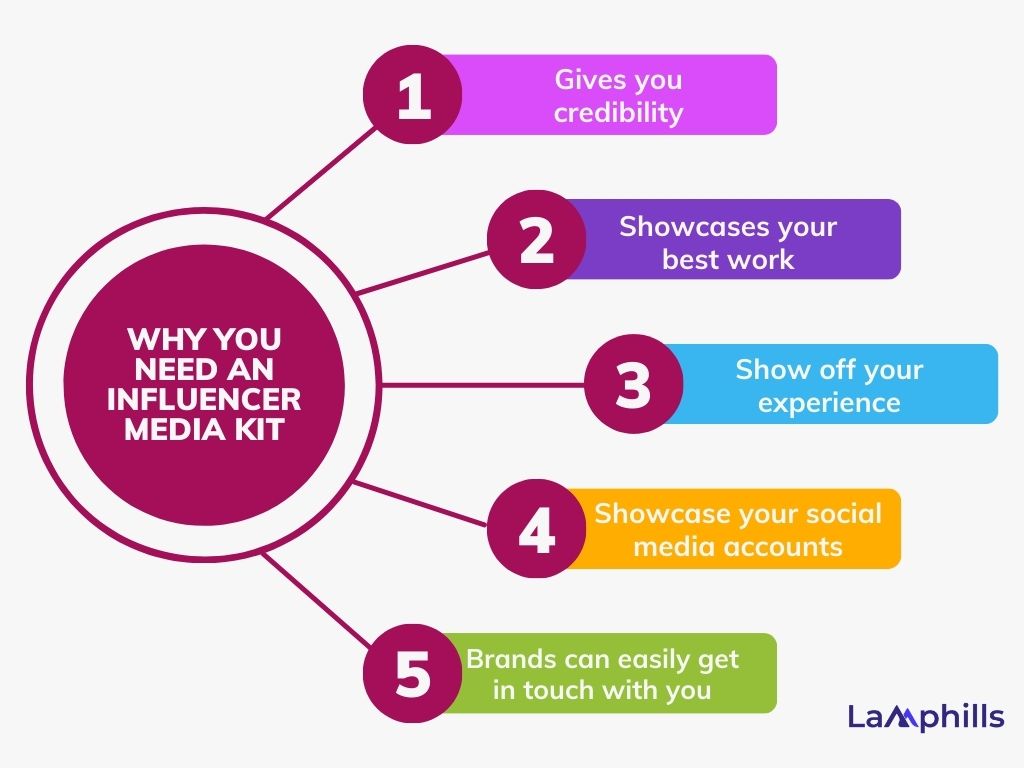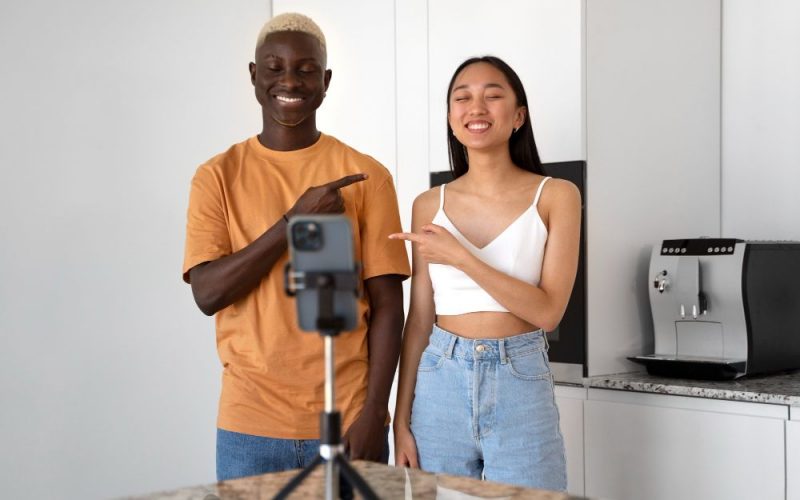We’ve all seen those movies where characters bite a gold coin to tell if it’s real. Now, I’m not a gold tester, so I cannot attest to the veracity of this procedure, but there is one I can attest to. If you want to check if an influencer is legit, check out their media kit.
Now, when you think about an influencer media kit, you probably think it has to do with a physical kit: equipment and tools and whatnot. Well, nope; that’s not it. It is more like a dating profile, a carefully curated portfolio that shows your best side.
And much like you wouldn’t just grab the last five photos from your camera roll when creating your dating profile, you shouldn’t haphazardly create your influencer media kit. The goal, in both cases, is to showcase your best self in the best light possible.
Key Point
- An influencer media kit is a document that influencers and content creators share with brands when discussing potential partnerships.
- An influencer media kit serves as a summary of your skills, values, and personal brand.
- You can easily create an influencer media kit using Canva.
- An influencer media kit gives you credibility and shows that you are a professional.
- If done right, a media kit can sell the skills and potential of an influencer at a glance. However, there are some key details and red flags to watch out for.
What Is An Influencer Media Kit?
An influencer media kit is a document that influencers and content creators share with brands when discussing potential partnerships. It is a professional document that social media influencers and content creators share with potential clients. Influencer kits typically include demographic information about your following and make it easy for potential collaborators to quickly understand your services.
Think of it as a digital portfolio—your media kit showcases your work, highlights your strengths, and summarizes your personal brand.
A great influencer media kit doesn’t need to be long—it can be a one- or two-page PDF or a page on your website.
A good media kit should:
- Showcase your strengths
- Prove that you have an engaged online following (e.g. by including follower stats)
- Highlight the kind of value you can bring to a potential client
Simply put, the purpose of a media kit is to convince others (businesses, collaborators, and other influencers you could potentially partner with) that you have the followers, the strategy, and the confidence it takes to boost their presence online—and, in turn, make them money.
Ideally, a media kit should be short and sweet (like a resume). It’s a visually appealing and concise snapshot of your online presence and achievements.
Components of an influencer media kit
An influencer media kit serves as a summary of your skills, values, and personal brand. Here’s what to include in your kit to appeal to brands:
A bio
Start with a short biography explaining your background, the type of content you create, and your expertise. A fashion influencer, for example, might mention that they attended design school, were featured on a magazine’s best-dressed list, or won a style award. Include contact details and, of course, links to your social media accounts.
Performance data
Provide information about how your content performs. List your active social media platforms, your follower count, average likes and impressions, blog traffic, and any other useful statistics.
Audience demographics
Include data that helps potential collaborators understand your following. Demographic metrics like gender breakdown, age range, and audience location make it easy for brands to see if your typical audience persona aligns with their target audience.
Engagement metrics
A strong engagement rate helps prove that you’re a credible influencer and that your followers are organic (discovered and followed your account naturally, not bought or fake followers). An influencer’s engagement rate is one of the most important aspects that brands consider.
For example, a nano-influencer with a niche, dedicated following may be a more appealing partner than a mega-influencer with a large and diverse following with limited engagement.
Past collaborations
Use your influencer kit to demonstrate the success of your previous collaborations. Information about how your sponsored content performed and the value it delivered to your partner helps prospective brands understand the benefits of partnering with you. Include performance statistics like post views, link clicks, and conversions.
Imagery
Featuring images and videos from your blog or social media posts helps potential clients understand the type of content they can expect and gives them an idea of your photography and editing skills.
Collaboration opportunities
Include an explanation of the different services you offer. If you produce multiple types of content—such as still photos, blog posts, and videos—highlight each medium. Influencers with a specific focus, like lifestyle bloggers, might also offer additional ways to collaborate, like recipe development or product reviews.
Steps to Create Your Influencer Media Kit
An influencer media kit can be as simple or as complicated as you make it to be. That said, here is an overview of what you need to do:
- Step 1: Pick a Tool to Help Create
- Step 2: Decide on Your Design
- Step 3: Gather Data You Will Need for Your Influencer Media Kit
- Step 4: What to Include in Your Influencer Media Kit
The checklist below goes into each point in detail:
Creating Your Influencer Media Kit
How to Create an Influencer Media Kit (with Canva)

Luckily, to create an Influencer Media Kit, you don’t need special design skills because everybody can do it using Canva.
To get started, open Canva and search for “media kit” in the search box. An extensive pool of templates will be shown in the search results. You also have an option to create a blank media kit.
The great part is that Canva’s library has media kit templates for every style, industry, and theme that are customizable. You have access to millions of professional stock photos, images, icons, illustrations, and other graphics with which you can personalize your media kit to stand out. Additionally, to add a personal touch, you can upload your own branding elements like a logo and images, and statistics screenshots. To add elements to your design, you can use the drag-and-drop tool.
Feel free to experiment with colors, fonts, backgrounds, etc. Make an influencer media kit that matches your style and aesthetic. Remember, your influencer media kit should look like an extension of your website or social media accounts. However, the best advice is to keep it simple and elegant since simplicity and elegance go hand in hand with most brands nowadays.
So, whatever style fits your personal brand, try not to overcomplicate things. The simpler something looks, the more likely it will be read by people who matter.
Another important thing is to be selective about what goes in your influencer media kit and not overload it with too many unnecessary details. To select what is necessary and what is not, ask yourself if that information is relevant and does it provide real value for potential clients.
In the end, save your media kit as a PDF or other preferable format and embed it on your website or share it directly with brands from Canva via email or your social media accounts.
Why Do You Need An Influencer Media Kit?
If you’re an influencer, you should have one of these handy documents on hand at all times. And here’s why:

It gives you credibility and shows that you are a professional
A media kit is a document that gives you credibility as someone who can be trusted with the task of telling the story behind some product or brand. It shows that you are a professional and gives brands insight into your personal brand.
Thus, a well-designed media kit is an effective tool for attracting new clients and growing your business. It shows you are serious about working with brands.
It showcases your best work
Furthermore, a media kit is your chance to show off your best work and highlight why you’re the perfect partner for a brand. Ensure that every piece of content in your kit is up-to-date and on its A-game.
It allows you to show off your experience
A good influencer media kit will give potential clients a clear idea of what kind of work you can do for them and why they should hire you. So, if someone wants to hire you for something specific, they can see what kind of experience you have in that field and fall back on it if needed.
If someone is interested in what you have to say, they can easily see all of your most recent posts and followers on Facebook, Twitter, Instagram, etc., without having to go through each account separately. Therefore, make sure to include links so people can easily find your other social media accounts if they don’t know about them yet!
Brands can easily get in touch with you
It makes it easy for other bloggers or companies to contact you directly with questions or requests for collaborations or sponsorships without having to sift through each piece of content individually online or through email threads where things get lost easily over time.
How to Evaluate An Influencer Media Kit
If done right, a media kit can sell the skills and potential of an influencer at a glance. However, there are some key details and red flags to watch out for. No doubt, you’re confident of your abilities to spot fake influencers, but while you shouldn’t assume the worst of an influencer, you have to think about what you want to get out of a partnership.
In a nutshell, brands should be mindful when browsing media kits.
Also, the influencer-consumer relationship is changing. Audiences are becoming more sophisticated and what you think is a “good” influencer might be different from what your audience thinks. Just some food for thought!
With that out of the way, let’s dive into the details of how to audit an influencer media kit.
Audience and niche
The clearer a creator is in terms of their content specialization, the better.
With the rise of nano-influencer and micro-influencer marketing, brands are moving away from one-size-fits-all influencers. The more granular you can get as a brand, the better. Some influencers will be upfront about which specific niches they’ve created content for.
An influencer that primarily publishes makeup reviews and how-tos will know by default what to say and which types of content resonate with beauty buyers. That said, there’s a difference between someone marketing themselves as a generalist “beauty influencer” versus a “K-beauty skincare creator.”
Follower demographics
It’s important to dig into the actual followers of any given influencer you want to hire. Some tools can automate this process for you. However, you should, at the very least, look at how creators speak to their followers and how those followers respond.
For example, do their followers’ questions, concerns and language resemble that of your brand’s audience? If “yes,” that’s a great sign.
Follower growth
Inconsistent posting doesn’t do influencers any favors when it comes to follower growth. Most creators experience a sort of snowball effect over time by posting regularly. Consistency can signal an authentic follower count while sudden spikes unrelated to viral content are a red flag.
On that note, follower count is definitely not the be-all, end-all of an influencer’s value to your brand. This is especially true given the rise of micro-influencers with smaller, more engaged followings.
Engagement metrics
The engagement rate is the measuring stick for many brands when it comes to influencers. That said, measuring engagement in a vacuum rarely tells an influencer’s whole story. This is often the case for macro-influencers who can earn massive engagement which isn’t reflected by their interactions-to-follower ratio. Context matters when auditing an influencer’s content.
Beyond engagement rate and interaction metrics, note the volume of content they publish and whether they’ve had any posts go viral.
Content formats and platforms
Influencer content can vary wildly from platform to platform.
For example, running TikTok campaigns requires someone with ample experience creating short-form videos. On the flip side, that same creator might thrive on Reels but struggle to create more polished Carousel-style content on Instagram.
As you browse influencer media kits, ask the following of the creator in question:
- Do they primarily post content on Instagram or TikTok? YouTube? Anywhere else?
- Is there content that is more off-the-cuff or professional and polished?
- Are they posting reviews, how-tos, and day-in-the-life content about brands? What else are they posting?
Brand alignment
Influencers are essentially an extension of your brand. As a result, having requirements and standards is important for the creators that you decide to hire. From their voice to their values, you should have a strong sense of what a creator is about and whether they’ll resonate with your audience.
Recommended Articles
- What Does Evergreen Mean In Business? Timeless Tactics for Lasting Growth
- MARKETING PROJECT MANAGEMENT: Unveiling Insider Tips and Strategies for Success
- How To Write A Personal Brand Statement Defines Your Professional Journey (With Free Templates)
- How Does Having a Social Media Policy Benefit a Business (+Free Policy Template)
- My Best Strategies For Audience Engagement With Free Template
- Social Media Etiquette: Best Practices






